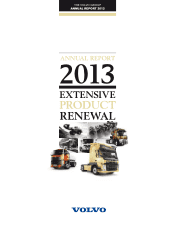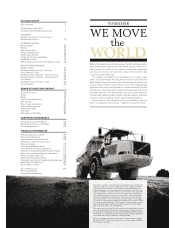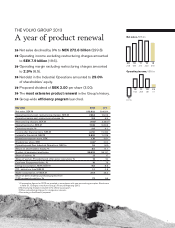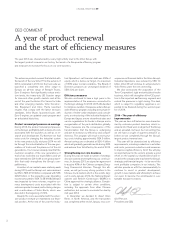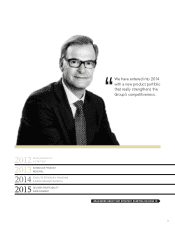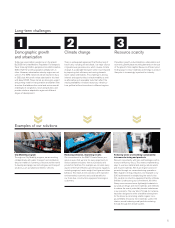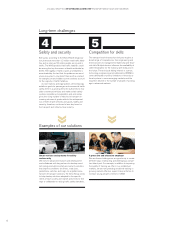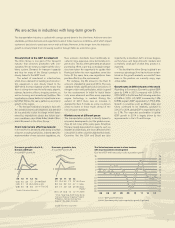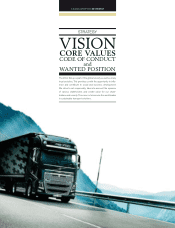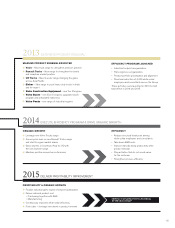Volvo 2013 Annual Report Download - page 11
Download and view the complete annual report
Please find page 11 of the 2013 Volvo annual report below. You can navigate through the pages in the report by either clicking on the pages listed below, or by using the keyword search tool below to find specific information within the annual report.
Closely linked to the GDP development
The Volvo Group is one part of the transport
industry that connects production with con-
sumption. We are what you might call the circu-
latory system. Demand for transport capacity
and thus for many of the Group’s products is
closely linked to the GDP trend.
The extent of investment in infrastructure,
which drives demand for building and construc-
tion equipment, is also closely linked to the
GDP trend. Increased global wealth means that
there is a long-term need to build roads, airports,
railways, factories, offi ces, shopping centers, as
well as housing and recreational facilities. The
registrations of new trucks on a particular mar-
ket often follows the same pattern as economic
growth in the region.
– The transport industry is largely in tune with
the overall economic development, but demand
for our products is also to a large extent deter-
mined by expectations about the future busi-
ness conditions, says Johan Adler, Head of Eco-
nomic Research in the Volvo Group.
Short-term factors affecting demand
In the short term, demand is affected by a number
of factors including fuel prices, interest rates, the
implementation of new emission regulations, etc.
New emission standards have traditionally re -
sulted in more expensive, more technically com-
plex trucks. This has often generated an ad vance
purchasing effect, a pre-buy, as haulage compa-
nies have taken the opportunity to update their
fl eets just before the new regulations come into
force. At the same time, new regulations have
positive effects on the environment.
For instance, the EU moved to the Euro 6
emission standard at year-end 2013. The new
standard entails signifi cant cuts in emissions of
nitrogen oxides and particulates, which is good
for the environment. In order to reach these
cuts, more advanced and thus more expensive
engine technology is needed. During the
autumn of 2013 there was an increase in
demand for Euro 5 trucks as some customers
chose to invest in these trucks ahead of the
new emission standards.
Markets move at different paces
The transportation industry is directly linked to
economic developments, but the global econo-
mies do not move at the same pace. Countries
that are heavily dependent on exports, such as
Sweden and Germany, are more affected when
consumers in other countries tighten their belts.
Countries like the USA and Brazil are also
impacted by a slowdown, but to a lesser degree,
as they have such large domestic markets and
a relatively small part of what they produce is
exported.
– The fact that the Volvo Group is global is an
enormous advantage. If we had not been estab-
lished on the growth markets, we wouldn’t have
been in the position we currently enjoy, says
Johan Adler.
Growth rates in different parts of the world
According to Consensus Economics, global GDP
grew by 2.4% in 2013 compared with 2.6% in
2012. GDP in the EU was fl at following a decline
of 0.4% in 2012. U.S. GDP increased by 1.9%
(2.8%). Japan’s GDP expanded by 1.7% (1.4%).
Growth in countries such as Brazil, India and
China continued to be relatively subdued in
2013. For 2014, global GDP is expected to grow
by 3.1%. The expected acceleration in global
GDP growth in 2014 is largely driven by the
improvements in the U.S. and Europe.
The transportation industry is cyclical with swings up and down in the short term. Add new emission
standards, political decisions and expectations about future business conditions, all of which impact
customers’ decisions to purchase now or wait until later. However, in the longer term, the industry’s
growth is closely linked to an increasing need for transportation as economies grow.
We are active in industries with long-term growth
Economic growth in the U.S.,
Europe and Brazil
Annual GDP-growth, %
0
Source: Consensus Economics
EU
Brazil
12
1.6
2.7
1.8
13
(0.4)
1.0
2.8
(0.0)
2.4
1.9 The U.S.
11
2.1
7.5
2.5
10
(4.5)
(0.3)
(2.8)
09
Economic growth in Asia
Annual GDP-growth, %
Asia/
Pacific*
India
Japan
* China, Hong Kong, South Korea, Taiwan,
Indonesia, Malaysia, Singapore, Thailand,
Phillippines, Vietnam, Australia, New
Zealand, India, Japan, Sri Lanka
Source: Consensus Economics
12
4.9
6.2
1.4
9.3
13
4.6
5.0
7.7
1.7
4.6
4.7
7.7 China
11
7.7
9.3
(0.4)
10.4
10
2.9
8.6
4.7
9.2
09
(5.5)
0
GDP growth (left axis)
New heavy-duty trucks registration growth (right axis)
(6)
(5)
(4)
(3)
(2)
(1)
0
1
2
3
4
5
6
%%
(60)
(50)
(40)
(30)
(20)
(10)
0
10
20
30
40
50
60
1210 1106 07 08 0905 13
The Volvo business moves in close tandem
with macroeconomic development
Euro area GDP and heavy-duty trucks registration growth
7

